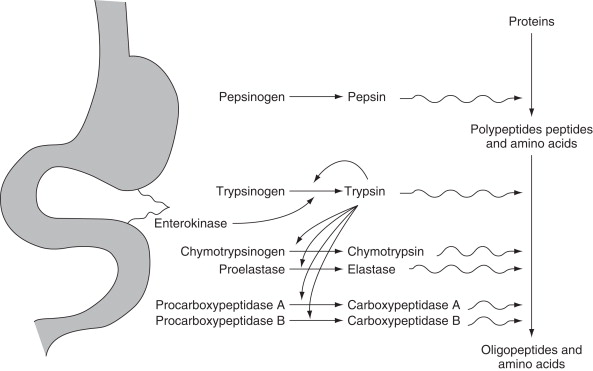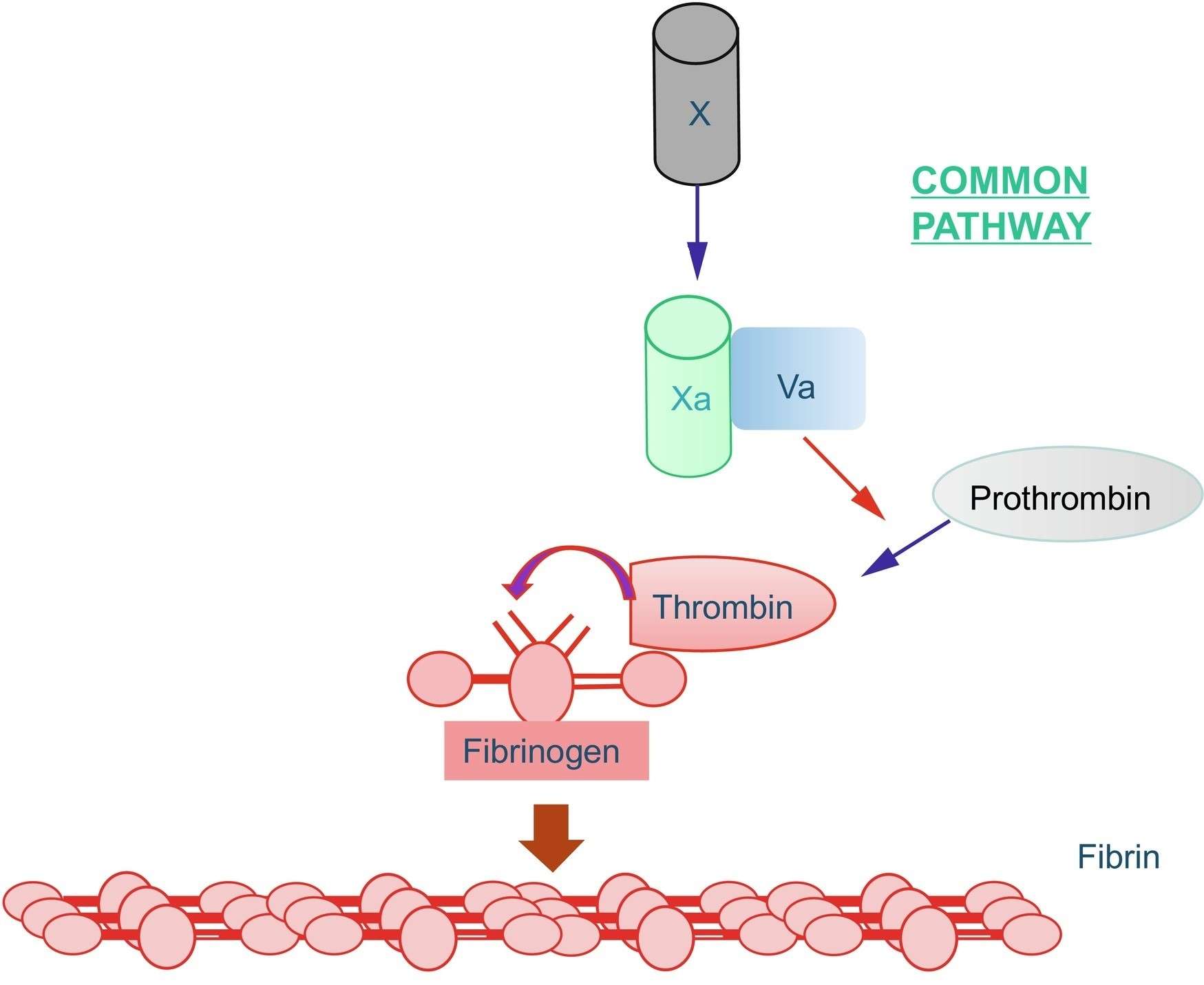Our Products Cannot Be Used As Medicines Directly For Personal Use.


Welcome! For price inquiries, please feel free to contact us through the form on the left side. We will get back to you as soon as possible.
Zymogens
Zymogens, also known as proenzymes, are inactive precursors of enzymes that require specific biochemical changes to become catalytically active. This regulatory mechanism prevents premature enzyme activity that could damage tissues or disrupt biological processes. Activation of zymogens is essential in several physiological pathways, particularly in digestion, blood clotting and immune responses. Their controlled activation provides temporal and spatial regulation of enzyme activity.
Creative Enzymes is one of the few companies in the world with the ability to supply a variety of zymogens. We are proud to be composed of groups of brilliant scientists who are dedicated to providing high quality products and satisfying services. Our products include different types of zymogens: human zymogens, bovine zymogens, and mouse zymogens. As a renowned supplier, Creative Enzymes offers the products with high quality and competitive cost performance. The unique and superior products distinguish Creative Enzymes from our competitors.
Activation of Zymogens to Active Enzymes
Activation of zymogens generally occurs by proteolytic cleavage. In this process, a specific peptide bond is hydrolyzed, removing an inhibitory peptide and allowing the active site of the enzyme to form or become exposed. For example, in the stomach, pepsinogen is activated to pepsin in the presence of gastric acid. In the pancreas, trypsinogen is converted to trypsin by enterokinase in the small intestine, which then activates other digestive enzymes. This regulatory mechanism ensures that enzymes remain inactive during storage or transport and are only activated in the appropriate environment.
 Fig. 1: Diagram of the zymogen mechanism.
Fig. 1: Diagram of the zymogen mechanism.
Types of Zymogens
Zymogens can be categorized based on the types of enzymes they produce and their roles in various biological systems. The major categories include:
Digestive Zymogens: Most of the digestive proteases produced in the pancreas are expressed as zymogens and stored in zymogen granules. The contents of these granules are released into the small intestine only during ingestion, and the zymogens are not activated until they enter the small intestine. The latter step is initiated by an intestinal protease, enterokinase. For example, pepsin is synthesized in the form of pepsinogen (Native Human Pepsinogen I and Pepsinogen II), an inactive zymogen which is secreted by the chief cells. Pepsin becomes active when the pH drops below 5 and works optimally at pH 2-3 in the acidic environment of the stomach. Activation of pepsinogen begins with hydrochloric acid (HCl) secreted by the parietal cells. The acid partially activates pepsinogen by drastically lowering the pH. The partially activated pepsinogen is then fully activated by another pepsinogen and converted to pepsin by cleaving a short peptide. In rare circumstances, inappropriate activation of these zymogens in the pancreas can lead to pancreatitis with devastating consequences. Similarly, trypsinogen produced by the pancreas is converted to trypsin in the small intestine by the enzyme enterokinase. Trypsin not only catalyzes protein breakdown, but also activates other digestive zymogens, such as chymotrypsinogen (Native Bovine Chymotrypsinogen A) and procarboxypeptidase (Native Bovine Carboxypeptidase A), further amplifying the digestive process.
 Fig. 2: Cascade of protein hydrolysis in the gastrointestinal tract (Caballero and Prentice, 2013).
Fig. 2: Cascade of protein hydrolysis in the gastrointestinal tract (Caballero and Prentice, 2013).
Coagulation Zymogens: These zymogens are central to the blood coagulation cascade, a tightly regulated process essential for controlling bleeding after injury. Inactive clotting zymogens circulate in the bloodstream until activated by specific triggers, ensuring that clot formation occurs only at the site of vascular injury. Prothrombin (Bovine Prothrombin, Human Prothrombin, Mouse Prothrombin), one of the major zymogens in this category, is activated to thrombin (Native Bovine Thrombin, Native Human Thrombin, Native Rat Thrombin), a key enzyme that converts fibrinogen (Native Bovine Fibrinogen) to fibrin, the structural matrix of blood clots. Sequential activation of coagulation zymogens, including factors such as Factor X and Factor VII, results in rapid and localized clot formation while minimizing the risk of harmful clots in healthy blood vessels.
 Fig. 3: Common pathway of coagulation (Winter et al., 2020).
Fig. 3: Common pathway of coagulation (Winter et al., 2020).
Immune Zymogens: The immune system relies on zymogens to trigger responses to pathogens and ensure that the body can mount a defense against infection. A key component of this defense is the complement system, a set of proteins that are activated in response to pathogens. C3 and C5, two central zymogens in this system, are cleaved into their active forms, which initiate pathways that lead to the destruction of invading microorganisms. Activation of these complement zymogens results in recruitment of immune cells, formation of the membrane attack complex (MAC), and lysis of pathogen cells. This system highlights the importance of zymogens in modulating immune responses, as their controlled activation prevents unnecessary tissue damage while effectively targeting pathogens.
Applications in Research and Industry
Zymogens have significant applications in a wide range of research and industrial sectors, where their unique properties are exploited for both scientific discovery and practical use. Their regulated activation allows for controlled enzymatic activity, making them invaluable tools in numerous fields.
Biomedical Research: Zymogens play a critical role in the study of enzyme regulation, structure-function relationships, and disease mechanisms. Researchers often use zymogens to study how enzymes are activated and the physiological processes that depend on that activation. For example, understanding the activation of digestive zymogens such as trypsinogen and pepsinogen can provide insight into gastrointestinal disorders such as pancreatitis, where premature activation of zymogens leads to tissue damage. Mutations in coagulation zymogens such as prothrombin or Factor VIII can cause bleeding disorders, making zymogens essential in the study of clotting disorders such as hemophilia. In addition, zymogens serve as valuable models for studying diseases involving protease dysregulation and enzyme activation, providing a basis for understanding cancer, immune disorders and degenerative diseases.
Biotechnology: In the biotechnology industry, zymogen-based systems offer great potential for controlled enzyme production and bioprocessing. Zymogens can be engineered to remain inactive until specific conditions are met, such as a change in pH, temperature, or the presence of an activator. This ability to fine-tune the activation of enzymes allows for controlled catalysis in industrial processes, including waste treatment, biofuel production, and pharmaceutical manufacturing. The use of zymogens in enzyme immobilization technologies is particularly beneficial in industrial applications, where enzyme stability and reusability are critical. By keeping zymogens inactive until required, industries can maximize enzyme efficiency and reduce waste, making bioprocesses more sustainable and cost-effective.
Food Industry: Zymogens are used extensively in the food industry, particularly in the production of dairy products. One notable example is chymosin, a zymogen commonly used in cheese production. Chymosin is activated to rennet, an enzyme that coagulates milk proteins to form the curds essential for cheese production. The controlled use of chymosin as a zymogen ensures that the enzyme's activity is triggered only under optimal conditions, allowing for precision in the cheese-making process. Zymogens such as chymosin, derived from natural or microbial sources, are increasingly favored for their ability to improve yield and texture in various dairy products. In addition, zymogens are being explored for their role in enhancing flavor and improving food safety through enzymatic treatments.
Pharmaceutical Industry: In the pharmaceutical industry, zymogens offer therapeutic potential, particularly by targeting their activation pathways. Drugs such as anticoagulants exploit the natural regulation of zymogens to treat or prevent disease. For example, warfarin and other anticoagulants inhibit the activation of prothrombin, thereby reducing the formation of blood clots, which helps prevent strokes, deep vein thrombosis (DVT) and other thrombotic conditions. This controlled inhibition of zymogen activation may be critical in the management of cardiovascular disease. Zymogens also hold promise in the development of enzyme replacement therapies, particularly for conditions where enzyme activation is impaired, offering potential new treatments for genetic or metabolic disorders.
 Fig. 4: Crystal structure of porcine pepsinogen, bovine trypsinogen, and bovine prothrombin (Structures from the Protein Data Bank).
Fig. 4: Crystal structure of porcine pepsinogen, bovine trypsinogen, and bovine prothrombin (Structures from the Protein Data Bank).
Creative Enzymes provides customers with all types of zymogens. The purity of all these products is greater than 90% as determined by SDS-PAGE analysis. These zymogens are believed to play critical roles in various biochemical reactions such as calcium ion binding, peptidase activity, phospholipid binding, protein binding, and serine-type endopeptidase activity. For many years, Creative Enzymes has manufactured and distributed a wide variety of enzymes and zymogens used in a wide range of research applications. By constantly striving for the highest quality, Creative Enzymes has earned the trust of countless customers and is proud to offer highly sophisticated research products. Creative Enzymes is committed to achieving the highest level of customer satisfaction and continuously improving its products, services and quality management. Please do not hesitate to contact us for any inquiries or questions!
References:
- Caballero, B., Allen, L., & Prentice, A. (2013). Encyclopedia of human nutrition (Third edition). Elsevier Academic Press.
- Winter, W. E., Greene, D. N., Beal, S. G., Isom, J. A., Manning, H., Wilkerson, G., & Harris, N. (2020). Clotting factors: Clinical biochemistry and their roles as plasma enzymes. In Advances in Clinical Chemistry (Vol. 94, pp. 31–84). Elsevier.